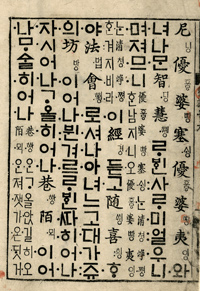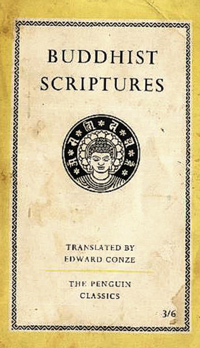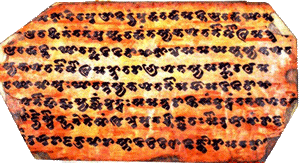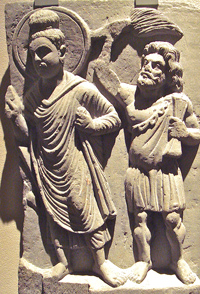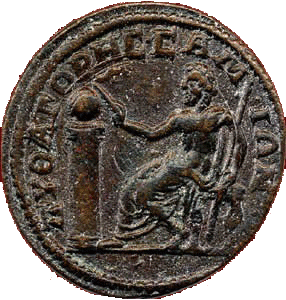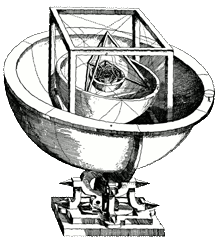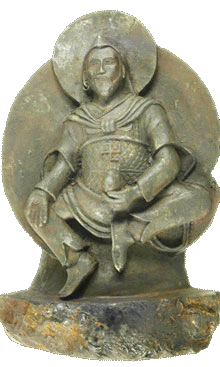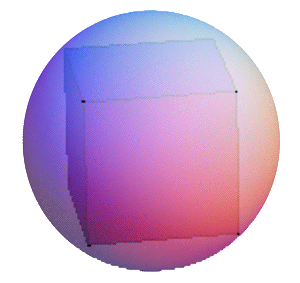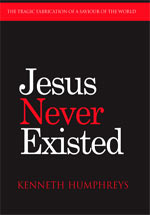
"Any serious New Testament scholar must know Sanskrit."
Professor Maurice Casey has told the world that no one who doesn't know Aramaic can understand the origins of Christianity.
But Professor Christian Lindtner says no one who doesn't know Sanskrit can understand the origins of Christianity!
Sanskrit is the oldest language in the world, with a history extending over three thousand years. The earliest example of the script is found in the Rgveda, a collection of Vedic hymns.
Sanskrit falls within the Indo-European family of languages and has some startling similarities with Greek and Latin, suggestive of some common point of origin.
Fragment of the Lotus Sutra, found in a Buddhist stupa (shrine) in Gilgit (Pakistan) in 1931.
Secret of the Christ?
In the SDP (at the end of the second chapter) the Lord will not reveal the secret of his profound identity to Säri-putras.
"It is a matter of faith only; it cannot be understood but only suggested by parabales, plays on words, etc." – CL.
The Lotus Sutra
The National Archives of India issued a facsimile edition of the Gilgit Lotus Sutra manuscripts in May 2012.
The Lotus Sutra, one of the most revered scriptures of Mahayana Buddhism, is said to be a discourse from the Buddha.
Some scholars date to the 2nd century AD, others to the 6th/7th centuries.
Greco-Buddhist syncretism
Zeus, as Vajrapāṇi, is the protector and guide of the Buddha in this relief from Gandhara (2nd century).
Sacred Geometry
Pythagoras touches a globe. Roman coin from Samos, from the time of Trajan.
To the Pythagoreans, the ten spheres of heaven revolved in perfect harmony about a central fire. The Pythagoreans also developed an elaborate lore of numbers, the "principle of all things".
In this, they were sharing a common wisdom with the Buddhist sages.
Johannes Kepler, 17th century astronomer and mathematician, interpreted the heavens as a 'sacred geometry'.
That "rock" connection
September 2012:
Carved from an ataxite meteorite that fell to earth 15,000 years ago, this 'Buddha with a sword and a swastika breastplate' gives poignancy to the 'rock- Sâri-putras – Simôn Petros' motif!
The Big Picture KH: I think it would be helpful if you were, initially, to sketch in the big picture. There are 27 books in the New Testament and a wealth of relevant material outside the New Testament, from Gnostics, heretics, etc. Are you arguing that only the gospels were pirated from Buddhist texts, all 27 books were, or all 27 plus much else as well? And can you say precisely which Buddhist texts were the source of these "pirate copies"? And why those Buddhist texts and not others?
The MPS is easily available in numerous translations into English from the Pâli. Trevor Ling has translated it in his The Buddha´s Philosophy of Man (Early Indian Buddhist Dialogues, London 1981, pp. 143-220). There is a very good and reliable translation from the Sanskrit and Tibetan by Claudia Weber, Buddhistische Sutras (Das Leben des Buddha in Quellentexten, München 1999, pp.105-271). Claudia Weber also includes a very good bibliography. Here you have all you need for a good start. The CPS was translated into German by Ernst Waldschmidt, Berlin 1957-1962. This is the basic work. It contains parallel Sanskrit, Pâli and Tibetan sources along with a fine German translation from the Chinese. An English translation from the Sanskrit was published by Ria Kloppenborg (The sûtra on the Foundation of the Buddhist Order, Leiden 1973). A Danish translation was published by myself in 1998 (in the book Hînayâna. Den tidlige indiske buddhisme, pp. 13-59). So, the first step for a beginner in comparative gospel studies is to get hold of Kloppenborg, Ling and Weber. Read these translations again and again, constantly comparing them with the numerous parallels you inevitably will find in the four New Testament gospels. If you do so, I am sure that you will be left with a feeling - as so many readers have already made this experience - that there is some sort of very close relationship at play. You will also feel a bit confused - what is going on here? The next step will be to get hold of a translation of the Lotus Sutra, the Saddharmapundarîkasûtram (SDP). It was first translated into English by H. Kern as The Lotus of the True Law, Oxford 1884. It was reprinted by Dover Publications, New York 1963, and is now even available online. H. Kern also edited the Sanskrit text, but there is no need to get into further details here. Reading the SDP you will easily discover some of the sources of the "Secret of the Christ", and many other familiar things. The SDP is a manual for Buddhist missionaries. It describes the "tricks" to be used to spread the gospel of mere faith in the Lord to the entire world. These tricks include the use of parables, puns, translations etc. - exactly what you find in the New Testament gospels. The SDP as well as the MSV were fundamental, even "canonical", when Indian Buddhist texts were rendered into Chinese (1st century AD) and Tibetan, and other languages. In other words, the fact that the New Testament gospels are based on these two bodies of text is "what we should expect". Once you have read the CPS, the MPS and the SDP in modern translations, you may wish to study Sanskrit, Pâli and Greek! It takes time, but you have to do so if you wish to go from "feeling" to "certainty", for, as said, my thesis is not based merely on similarities and parallels etc., but on hundreds of observations of direct literary relationship.
The Jewish Connection KH: How would you respond to the widely held view that the gospels are primarily informed by the Old Testament, from which many Jesus words and deeds appear to be a reworking? I imagine a group of Buddhist monks, some of them Jews, sitting around the same table. You can easily imagine the fun: Take two different books. Combine words and numbers etc. from one with the other. Soon you have a new story - still faithful to the originals.
Table fellowship
Not only is four a holy number for the Buddhists, but the MPS of the MSV also refers to the four main disciples. As known, the present division of the four gospels into chapters is not original but rather late. Could it be that the original number of chapters was 4 x 27 = 108 (an important number to the Buddhists)? In general, the idea of having several "parallel versions" of the same events is typical Buddhist. In Pâli, the sûtras are arranged in four groups (nikâya, Dîgha, etc.) When I say that the authors were Buddhists and Jews, I am also saying that some of them were also Pythagoreans. I find traces of Pythagoreanism in the fundamental Buddhist text on the Middle Way/Path (cf. my analysis in Lockwood, op. cit., p. 150).
But which New Testament text? KH: We have heard a lot about the orthodox corruption of scripture. Do we really have the original texts? What does your thesis have to say regarding the doctrinal battles of the 2nd and 3rd centuries, the sectarian strife, the "inauthentic" epistles, etc.?
Only recently, as pointed out by the numerical analysis of Smit Sibinga, et al., can we confirm how great a work the earlier philologists have accomplished. In a few cases the Buddhist texts confirm the textus receptus. To speak of an "earlier version" of the New Testament gospels is, in my view, pure speculation. There are, in fact, very few "real variants" (often confused with variants in general). In a few cases Nestle & Aland have to be corrected in view of gematria, e.g. Daueid (424), with earlier editors (and mss, of course), not Dauid. I have not much to say about the doctrinal battles etc. at present.
For Example? KH: I think it's fair to say when first presented with the idea that the gospels are pirated from Buddhist texts, people will ask for examples of this copying. Can you give two or three instances where a verse is to be located in a Buddhist text and an identical text is to be located in the textus receptus? Are these Buddhist texts widely available in translation so that your claims can be verified?
To make my point very clear: I claim that the four New Testament gospels are Buddhist sutras in Greek. If you take a modern English translation of the New Testament and compare it with the Greek, you will not want to say that we are here merely dealing with similarities and parallels. There is more. There is a direct literary relationship. For example, take "Brother of the Lord". I have no direct Buddhist source for 1 Galatians 18-19 but here we find Kêphas and Iakôbos, so I assume - in the light of 1 Corinthians 15:5-7 - that "the brother" is again the main disciple of the Buddha, viz. Kâsyapa(s)/Kassapa. (K-P-S = K-PH-S = K-B-S) - vowels left out in Hebrew script!). In other cases adelphos (also MPS) renders Sanskrit upâsakas, layman, the "more than" 500 laymen who had passed away. My book Geheimnisse um Jesus Christus was first published by the small German publisher Lühe-Verlag in 2005, and reprinted with some minor corrections in 2011. This book, the Geheimnisse, is intended for students who read Sanskrit and Greek. My website, www.jesusisbuddha.com is likewise intended for those who read the original languages. But to give an illustration from Geheimnisse, p. 110-111, where I provide the Sanskrit source, I pointed out how the 46 syllables of Luke 10:40 "transcreate" 46 syllables of the MPS. The value of the original consonants are carefully reproduced. The difficult autous kai autos in Luke becomes clear in the light of the Sanskrit phrase cârikam caran, etc. This odd way of "translation" corresponds exactly to the "method" used by Aquila when he "translated" the Hebrew Old Testament (see the examples given in Natalio Fernández Marcos, The Septuagint in Context, Leiden 2000, pp. 115-118.) This "borrowing" took place around 1900 years ago.
When and Where? KH: Christian, you say that the gospels are "transcreations" from earlier Buddhist sources. Is there anything you can point to other than the texts themselves to support this view? Where and when did this "borrowing" occur?
I have no external or internal evidence to suggest exactly where it took place. Alexandria would be nothing more than an educated guess. Jewish texts have been found in Gandhâra. The same, as a rule, goes for the Buddhist sûtras. We do not know where they were composed. Most likely in some Buddhist monasteries. We are not supposed to know. One of the first scholars to have followed in my footsteps is professor emeritus Michael Lockwood. He concluded that my work had "firmly established" that the Greek of some parts of the New Testament was based on a "transcreation" from Pâli and Sanskrit. Other scholars who follow in his and my footsteps will, I am sure, come to the same conclusion. But it takes time. Nevertheless, I am convinced that all who take an interest in comparative gospel study can get a "feeling" about the direct literary relationship that I claim simply by reading modern translations of some of the major Buddhist sûtras in question. Fortunately, some of these are available in German and/or English. The main source, MSV, has not been translated in toto, but some parts have been translated, viz. Catusparisatsûtra (CPS) and Mahâparinirvânasûtram (MPS).
"Parallelomania"?
The Sanskrit text was first published in Rome (1977-78) by Raniero Gnoli, a student of the late Prof. G. Tucci, the famous Buddhist scholar. In 1981 or so, I was asked by the editor of the journal Acta Orientalia to prepare a review of this Sanskrit text (three volumes). I did so, and the brief review appeared in Acta Orientalia 43 (1983, pp. 124-126). At that time I had no idea at all of the importance of the MSV for comparative gospel studies. As far as I am aware, it is now almost impossible to procure a copy of this book, new or second-hand. How can that be? (Does Benedict XVI know the answer?) Anyhow, the Sanskrit text is still available in some libraries. I have been in touch with numerous theologians since 1998. It is quite clear that they do NOT want to hear anything about comparative gospel studies. The same goes for the many historians of religion that I know of in the universities etc. The reasons are obvious: The professional theologians risk their livelihood by subscribing to my thesis about comparative gospel studies. Historians of religion - at least in Denmark - lack knowledge of Greek and Sanskrit etc. But little by little the situation will change. There is a world outside Denmark. There will be good students who will take up comparative gospel studies. Eventually, some university or institution will find the funds to establish an institute or seminar and others will follow. "Comparative Gospel Studies" will flourish but it may not be in my time. The opposition is still tremendous! The main task of such an "Institute of Comparative Gospel Studies" will be simple and clear. A critical edition of the entire MSV, on the basis of Sanskrit, Pâli, Chinese and Tibetan, has to be established and it will take a team to do so. On that basis a scholarly German and English translation has to be prepared. Once this has been done, the comparative work can start, word for word, sentence for sentence ... Eventually, you will have German professorships in "Sanskritisms in the New Testament gospels", " Putras & Petros", "The 500 brothers", "The Secret of the Lord", "Mary and Âmra", etc. etc. It will then be clear, I am quite sure from the examples already pointed out by myself and others, that we are by no means speaking of mere parallels, but of direct literary relationship. The distinction is not difficult to make.
Thousands of variants?
The truth (regarding the gospels) is that there are numerous variants, but not that many REAL variants. (See P. Mass or Nestle or Metzger on textual criticism. Bruce Metzger discusses some of the REAL variants.) I'd like to be clear on this. I am, if I may add, not to be found among those who suspect that the textus receptus of the New Testament gospels contains many later interpolations etc. On the contrary. There was an early tradition among Jews and Buddhists - not to mention the authors of the Rigveda! - of carefully counting the number of syllables (aksara in Sanskrit).
Trajectory of development? KH: Syllable counting would surely introduce rigidity into the texts. Does your thesis allow for any trajectory of development, reflective of doctrinal battles, for example?
Jewish scribes counted the number of words and syllables of the Torah - as did the authors/editors of the Rigveda (432.000 syllables = 4 x 108.000). They were called Sopherim. Those responsible for the Greek New Testament (not just the gospels!) were also Sopherim, and we, too, have to be Sopherim!
The alternative endings of Mark's gospel? KH: But to press the point and to be specific, it is generally understood that Mark's gospel was the first and, in the "earliest and best manuscripts", ended at 16.8. In your judgement, were or were not verses 9 to 20 part of the original "syllable count"? To take another famous example, was the woman taken in adultery original to the text or not?
The woman taken in adultery was original in the sense that it left the hands of the authors in the form we find it in the textus receptus. I have not identified a Buddhist source. Matthew was, as the ancient Christians opined, the first, not Mark.
This means that what we read in Matthew actually follows what was reported by disciples in the MSV. All Buddhist gospels are presented as being something reported by disciples, e.g. Â-nan-das, who typically becomes Iô-an-nês, etc. KyMâRaS becomes MaRKoS. Behind LouKaS we have LoKa(S) - part of a compound, the second part meaning physician. So, "Matthew" did the first great job. There was no reason for Mark and Luke to repeat. When I then look at passages found in Mark and Luke, I see that they too have been using the same source as Matthew, but inserted words left out by Matthew. John is more independent, but he shares the source for the good shepherd with Luke. You would not know that it was the same story if you did not have the MPS source: You take this, I take this - that was how they worked. Hence I am speaking of the same table. The story fabricated would then seem quite credible, for we have four independent witnesses. Most, if not all "errors" are deliberate, for the same reason - humanum errare! With regard to the "truncated" version of Mark. Here there is in fact an obvious explanation: In the MSV (p. 57, ed. Gnoli), KuMaRaS is said to have a crooked or truncated finger. The Sanskrit is kutila-angulikayâ. He moves a very heavy bowl "with his crooked" finger (serving as a hook). This is imitated by the the Greek-Latin kolobo-daktylos, said of Mark, with a "short-finger". You know the speculations of the theologians! So what happened is this: Reading the MSV p. 57, they decided to let Mark be a shortened version, ending abruptly! More in Lockwood, pp. 232-233 ("Who wrote the New Testament Gospels", 2010). The interrelationship cannot possibly be denied, and it only works one way - from Sanskrit to Greek. So this is to me a very important argument. The Sanskrit compound belongs to a list of similar compounds in the instrumental case, and it is attested in the earliest Buddhist scriptures. Nativity? KH: Is it your contention that the nativity stories found in Matthew and Luke were pirated from Buddhist originals?
Both of them decided that they would, like the MSV, have to begin with a book of genesis - a feature shared by Old Testament and MSV (the genesis of the world, and the genesis of the Buddha´s family - genesis in common).
Matthew has 3 x 14 names = 42. The first Buddhist text "translated" into Chinese, was/is in 42 sections. Q source KH: So, in your opinion, is it possible that "sayings of the Buddha" are the material sourcing the elusive and theoretical "Q" ?
Pauline epistles?
One begins with 1 Corinthians 15:5-7, based on two passages in the MPS (Päli + Sanskrit available). The "more than 500 brothers" (adelphos) is decisive for the identification of the source. With the MPS in hand you see that Kêphas and Iakôbos are but two different "transcreations" of one and the same main disciple, Kâsyapa(s) (Pâli: Kassapa). He was the leader of the 500 monks (bhiksus, plural: bhiksavas). So here the Greek brother was the Pâli/Sanskrit monk, beggar! Yes, Buddhist teachers beginning with Nâgârjuna would write letters about the Dharma addressed to a famous ruler. Did he ever receive those letters? We do not know. Most of these letters (lekha) have been edited and translated by my friend Sieglinde Dietz in Göttingen. I myself have translated the most important ones into Danish. The Mahâyâna tradition of writing letters continued for almost 1000 years. So it would have been natural for the "Christians" to follow this tradition. On the other hand we also have Greek and Roman letters. Did this tradition inspire the (Pythagorean) Buddhists? Could be, for we also have many Pythagorean letters from the Hellenistic period.
KH: Professor Lindtner, thank you for sharing your thoughts and your time. CL: Thank you
His claims cannot be verified by researchers without the requisite Sanskrit skills, yet few will tread that laborious path, simply based on his assurance that it is so. Can we even establish from archaeology an early Buddhist presence in the Levant? Substantiating the place, the time and the method of possible transmission would go a long way towards supporting the thesis that transmission of Buddhist texts into Christian scripture did in fact occur. But certainly that possibility is an interesting contender.
PS: The Arcane wisdom of Gematria The cube of Kêphas within the globe of Sâri-putras!
Copyright © 2004
by Kenneth Humphreys.
|
||||||||||||||||||||||||||||||||||||||||||

